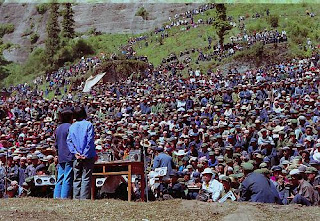EXPLORERS OF THE WORLD
Sir Wilfred Thesiger (1910 – 2003)
Sir Wilfred Patrick Thesiger, CBE, DSO, FRAS, FRGS (3 June 1910 – August 24, 2003) was a British explorer and travel writer born in Addis Ababa, the capital of Ethiopia.
Thesiger was educated at Eton College and Magdalen College, Oxford University where he took a third in history. Between 1930 and 1933, Thesiger represented Oxford at boxing and later (1933) became captain of the Oxford boxing team.
In 1930, Thesiger returned to Africa, having received a personal invitation by Emperor Haile Selassie to attend his coronation. He returned again in 1933 in an expedition, funded in part by the Royal Geographical Society, to explore the course of the Awash River. During this expedition, he became the first European to enter the Aussa Sultanate and visit Lake Abbe.
Afterwards, in 1935, Thesiger joined the Sudan Political Service stationed in Darfur and the Upper Nile. He served in several desert campaigns with the Sudan Defence Force (SDF) and the Special Air Service (SAS) with the rank of major.
In World War II, Thesiger fought with Gideon Force in Ethiopia during the East African Campaign. He was awarded the DSO[1] for capturing Agibar and its garrison of 2500 Italian troops. Afterwards, Thesiger served in the Long Range Desert Group during the North African Campaign.
There is a rare wartime photograph of Thesiger in this period. He appears in a well-known photograph usually used to illustrate the badge of the Greek Sacred Squadron. It is usually captioned 'a Greek officer of the Sacred Band briefing British troops'. The officer is recognisably the famous Tsigantes and one of the crowd is recognisably Thesiger. Thesiger is the tall figure with the distinct nasal profile. Characteristically, he is in Arab headdress. Thesiger was the liaison officer to the Greek Squadron.
In 1945, Thesiger worked in Arabia with the Desert Locusts Research Organisation. Meanwhile, from 1945 to 1949, he explored the southern regions of the Arabian peninsula and twice crossed the Empty Quarter. His travels also took him to Iraq, Persia (now Iran), Kurdistan, French West Africa, Pakistan and Kenya. He returned to England in the 1990s and was knighted in 1995.
Thesiger is best known for two travel books. Arabian Sands (1959) recounts his travels in the Empty Quarter of Arabia between 1945 and 1950 and describes the vanishing way of life of the Bedouins. The Marsh Arabs (1964) is an account of the Madan, the indigenous people of the marshlands of southern Iraq. The latter journey is also covered by his travelling companion, Gavin Maxwell, in A Reed Shaken by the Wind — a Journey through the Unexplored Marshlands of Iraq (Longman, 1959).
Thesiger took many photographs during his travels and donated his vast collection of 23,000 negatives to the Pitt Rivers Museum, Oxford.
Obituary from The Guardian, August 27th 2003
Explorer whose mystic vision rejected the modern technological world in favour of the tribes people of Africa and the Arabian deserts
Once, in 1946, Wilfred Thesiger lay starving on a sand dune in Arabia’s Empty Quarter for three days, waiting for his Bedu companions to bring back food, and tortured by hallucinations of cars and lorries that could carry him to safety. “No,” he wrote later, “I would rather be here starving as I was than sitting in a chair, replete with food, listening to the wireless and dependent on cars to take me through Arabia.” As an explorer, Thesiger, who has died aged 93, recognised that satisfaction in attaining a goal was directly in proportion to the hardship and challenge involved in getting there.
He reserved the word “abomination” for cars and aeroplanes, and all his life resented the intrusion of any innovation post-dating the steam engine. His mystical regard for tradition was a product both of his childhood in still-medieval Abyssinia and an intense pride in his aristocratic forebears, the Barons of Chelmsford.
Born in Addis Ababa, where his father was British minister, he grew up in the barbaric splendour of an imperial court, and was privileged to see a victorious and blooded Abyssinian army marching through the city in the full panoply of war. It was an experience he never forgot.
Daydreams of Africa and the wider world were his means of escape throughout his awkward and often unhappy schooldays at St Aubyn’s school, Rottingdean, in Sussex (1919-23), Eton College (1923-28), and his time reading history at Magdalen College, Oxford (1929-33). During his first summer vacation from the university, he set off alone, working his passage on a tramp steamer to Istanbul and returning third-class by train.
So began the travels that he recorded in fine prose and black-and-white photography. On his return, he found both a personal invitation to attend the coronation of Emperor Haile Selassie of Abyssinia, and a note from the Foreign Office appointing him honorary attaché to the Duke of Gloucester for the event - where he met Evelyn Waugh, a writer of very different sympathies.
For his second vacation, he set himself another endurance test, a month with a Hull fishing trawler off Iceland. Here he learnt to withstand the need for sleep.
But Africa was his goal, and at the age of only 23 he went to explore Abyssinia’s Awash River and the forbidding Aussa sultanate with its Danakil nomads, chiefly noted for a disturbing tendency to kill men and carry off their testicles as trophies. Such practices held little horror for Thesiger, who had survived fagging and flogging at Eton, and saw at least one young Afar man, flushed from the exertion of slaughtering and mutilating four victims in a day, as “the equivalent of a nice, rather self-conscious Etonian who had just won his school colours for cricket”.
Thesiger gained his own blue, for boxing at Oxford - when he captained the university team in 1933, a victory against Cambridge was marred by the breaking of his noble nose - and like many an athletically endowed young Oxbridge graduate of the 30s, he sought a career in the country where “blues” were said to rule “blacks”: the Sudan. As an assistant district commissioner in the Sudan political service from 1935 onwards, he served in arid Darfur, and later in the steaming swamps of the Sudd, where one of his chief jobs was shooting troublesome lions that attacked local herds.
It was in Darfur that he first learned to travel by fast-riding camel with local companions, dressing as they did, eating local food out of the same bowl, and asking nothing of technology but a good rifle, a torch and a compass. During one leave he completed a long and dangerous journey to the almost unknown Tibesti mountains in the Sahara, and fell in love with the desert: “I was exhilarated by the sense of space, the silence, and the crisp cleanness of the sand. I felt in harmony with the past, travelling as men had travelled for untold generations across the deserts, dependent for their survival on the endurance of their camels and their own inherited skills.”
During the war he was a bimbashi - the most junior officer rank - in the Sudan defence force. He won the DSO in 1941 for leadership under fire in fighting the Italians, under the idiosyncratic Orde Wingate in the liberation of Abyssinia. With a masterstroke of bluff, he subsequently forced the surrender of an Italian-held fort, taking 2,500 prisoners. He later fought as a major, as second in command of a Druze legion formed to fight the Vichy French in Syria - which enabled him to visit a deserted Petra. He also served with Colonel David Stirling’s Special Air Service (SAS) in north Africa. Following the defeat of the Afrika Korps in 1943, the SAS went to Palestine, and in October of that year Thesiger left the organisation to act as an adviser to Haile Selassie in Abyssinia.
A resulting chance meeting brought him a job in what became the UN’s Food and Agricultural Organisation’s anti-locust unit and the opportunity to make his most famous journeys in the deserts of Arabia under its aegis, between 1945 and 1949. Arabia’s legendary Empty Quarter had been the goal of all Arabian explorers from Richard Burton onward, and although Thesiger was not the first to cross it, he was the first to explore it thoroughly, mapping the oasis of Liwa and the quicksands of Umm As-Sammim. He crossed the desert twice with Bedu companions, and his trek across the western sands from the Hadhramaut to Abu Dhabi was the last and greatest expedition of Arabian travel.
During his journeys he was caught up in inter-tribal raids, pursued by hostile raiders, and arrested by the Saudi authorities. He travelled alone in the Hejaz, the Assir and Najran, and explored the Trucial Coast and Dhofar in southern Arabia. He lived with the canoe-borne marshmen of Iraq for several periods over the seven years up to the Iraqi revolution of 1958, attaining acceptance only by learning the unusual skill of circumcision.
He still found time to travel in Kurdistan, Hunza (north-east Pakistan), Swat, Chitral (both north-west Pakistan), and Nuristan (across the border in north-east Afghanistan), where in 1956, 16,600ft up in the high passes, he bumped into a dispirited Eric Newby and friend Hugh Carless, and invited them to spend the night with him. They got on well until Thesiger saw them blowing up inflatable air-beds before retiring. “You must be a couple of pansies!” he said.
He crisscrossed postwar Abyssinia, fought on the royalist side in the civil war in Yemen (1966-67), traversed most of northern Kenya, where he spent much time between 1968 and 1994, travelled with the Bakhtiari nomads in Iran, trekked across the burning plains of the Dasht-i-Lut, the Great Sand Desert of eastern Iran, and explored inner Afghanistan. All of these travels and many more - in total tens of thousands of miles - were made either on foot or by traditional transport, be it camel, horse, mule, donkey or canoe.
Thesiger felt least at home in his own culture and with his own kind. He resented the juggernaut of western “civilisation” and its inexorable movement to squash what he believed was the colour and diversity of the earth’s peoples. His sympathies were with the indigenes, and his closest human ties were with certain of them who were his companions on his many journeys - his Zaghawa servant in the Sudan, his Bedu companions in Arabia, his paddlers in Iraq and his Samburu family in Kenya. (”Sex has been of no consequence to me, and the celibacy of desert life left me untroubled. Marriage would certainly have been a crippling handicap.”) Few other explorers of the last century have tried so genuinely to see the world through the eyes of these foreign peoples. Yet much as he despised civilisation, Thesiger was never able to forsake completely his place in it.
Had he done so, he might never have left us his unique glimpses of strange worlds, in his classic books The Marsh Arabs (1964) and Desert, Marsh And Mountain (1979), his autobiography The Life Of My Choice (1987), his portfolio of superb monochrome photos, Visions Of A Nomad (1987), and above all his description of the traditional life of the Bedu, Arabian Sands (1959), probably the finest book ever written about Arabia and a tribute to a world now lost forever.
He won the founder’s medal of the Royal Geographical Society, together with three other medals from learned societies, honorary fellowships of Magdalen College, Oxford, and the British Academy, and an Honorary DLitt from Leicester University. In 1968, he was awarded a CBE, and in 1995 he was knighted.
Yet, far more than these many honours, he valued the friendship and confidence of the nomadic peoples with whom and among whom he travelled. Thesiger’s best years were the five he spent among the Bedu of South Arabia, and one cherished companion from those days, Salim bin Ghabeisha, when a greybeard in his 60s, remembered him: “He was loyal, generous, and afraid of nothing. He was a wonderful man to travel with.” Thesiger would, I am sure, ask no better epitaph.
Copyright: Wikipedia, Oxford University Exploration Club

















